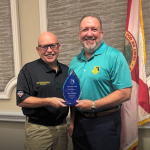
Stacey Moser to lead Commercial Services business
July 21, 2025
Gary Goble shows how technology can build trust and changes driver behavior
July 24, 2025
Verra Mobility recently conducted a traffic study revealing safety concerns surrounding multiple Clark County School District (CCSD) school zones near Las Vegas, NV. Partnering with local officials, the company analyzed vehicle speeds over a three-day period at just five of the county’s 373 schools. The findings highlight a pressing need for stronger protection: so far this year, 119 CCSD students have been struck by vehicles while traveling to or from school.*
Disturbing Data
The key findings tell a powerful story of unlawful behavior around schools as well as troubling concerns for student safety:
- 11,901 potential speeding violations were recorded — an average of nearly 4,000 per day
- 3,449 violations occurred while school zone beacons were flashing – a time when students, staff, and family members are actively walking to and from school
- 938 vehicles exceeded the posted school zone speed limit by more than 20 mph
High-Risk Hotspots
While three of the schools accounted for 77 percent of the total potential violations, there were additional alarming statistics:
- Sierra Vista High School recorded 3,984 violations which accounts for 17% of all traffic
- Cashman Middle School registered 2,706 speeding violations where 492 of these traveled at more than 60 mph
- Gehring Elementary School recorded the highest speeders with 35 vehicles traveling more than 70 mph in the school zone
A Wake-Up Call
Speed studies in school zones help districts understand the extent of speeding behavior, identify high-risk areas, and explore strategies to improve traffic safety and protect children. Every speeding vehicle in a school zone is a potential danger to a child. Protecting students, parents, and educators starts with awareness—and continues with accountability.
As a leader in automated traffic safety technology, Verra Mobility partners with communities to implement programs proven to reduce speeding by up to 70%. These results show that automated enforcement not only works, it saves lives.

